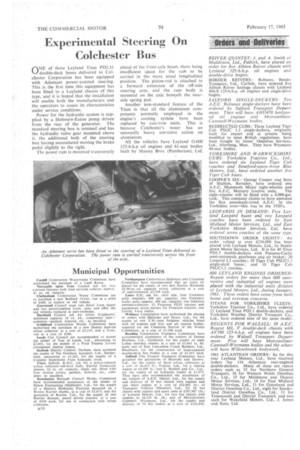Experimental Steering On Colchester Bus
Page 44

If you've noticed an error in this article please click here to report it so we can fix it.
ONE of three Leyland Titan PD2.31 double-deck buses delivered to Colchester Corporation has been equipped with Adamant power-assisted steering. This is the first time this equipment has been fitted to a Leyland chassis of this type, and it is hoped that the installation will enable both the manufacturers and the operators to assess its characteristics under service conditions.
Power for the hydraulic system is supplied by a Hobourn-Eaton pump driven from the rear of the generator. The standard steering box is retained and has the hydraulic valve gear mounted above it. the additional bulk of the steering box having necessitated moving the brake pedal slightly to the right.
The power ram is mounted transversely ahead of the front-axle beam, there being insufficient space for the ram to be carried in the more usual longitudinal position. The piston-rod is attached to a forward extension of the off-side steering arm, and the ram body is mounted on the axle beneath the nearside spring pad.
Another non-standard feature of the Titan is that all the aluminium components normally employed in the engine's cooling system have been replaced by cast-iron units. This is because Colchester's water has an unusually heavy corrosive action on aluminium.
All the vehicles have Leyland 0.600 125-b.h.p oil engines and 61-seat bodies built by Massey Bros. (Pemberton), Ltd.




















































































































